A world hotspot for marine biodiversity
Indonesia stands right in the middle of the Coral Triangle, a roughly triangular zone spanning from Solomon islands to the east, Philippines to the north and Borneo to the west.
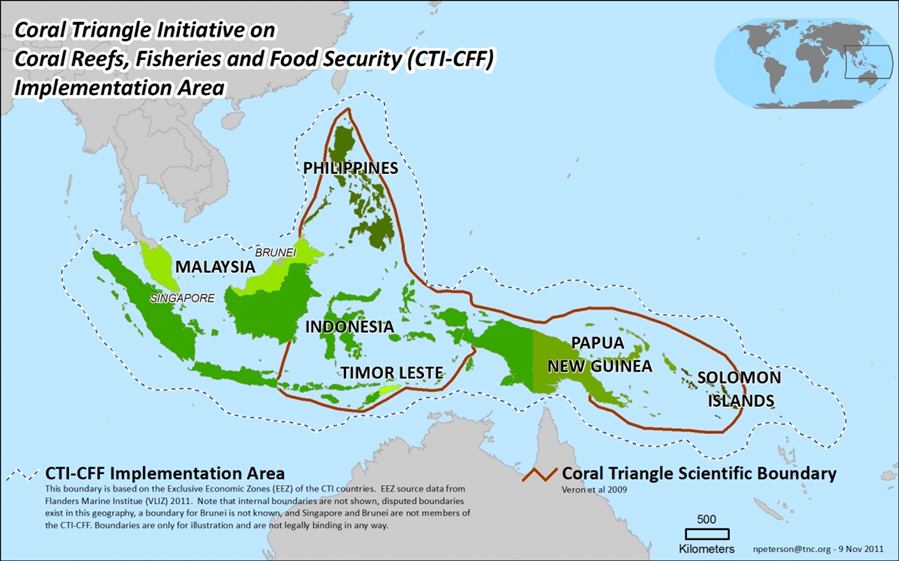
The Coral Triangle is named after the exceptional diversity of coral it shelters :
- No less than 3/4 of the world known coral species are found there, in an area covering less than 2% of Earth
- Half of the world’s coral reefs (by size !) are located within the Coral Triangle (as well as the largest extent of mangrove forest in the world)
Coral reefs themselves are the marine habitat hosting the highest diversity of fish on Earth. There would be at least 5’000 reef fishes in the world’s ocean but maybe up to 8’000 : “the variation in the number depended mostly on competing definitions of a“coral reef fish”and the estimate of undiscovered species in remote and deep habitats” (Victor 2015).
Indeed, each year, new species are described. For instance in March 2018, no less than 9 new reef fish species were identified off Fakfak district (West Papua) during a two-week expedition (Mongabay).
It is estimated that nearly 3’000 species of reef fish are found within the Triangle Coral : for this matter, it’s the richest place on Earth.
And if the Coral Triangle is the heart of the world marine biodiversity, Indonesia would be its epicenter.
No other country in the world has a higher marine biodiversity than Indonesia : roughly 2’000 species of reef fishes (including about 100 endemic species).
Raja Ampat archipelago probably holds the world record for the highest reef fish concentration with 1’320 different species reported (Allen and Erdmann 2009).
And it doesn’t end to reef fishes :
- 569 species of coral have been reported across the country. It’s 69% of the total coral known species (Indonesian Institute Of Science LIPI)
- 117 species of shark out of c. 500 known species are found in Indonesian waters (Indonesian government sharks & ray 2016-2020 conservation plan).
- 101 species of ray out of c. 650 known species (WCS)
- 34 species of cetacea out of 89 known species (Ministry + Wikipedia).
- 6 out of 7 species of sea turtles
I found the following remarks in a 2014 report (ADB 2014) :
“The Lesser Sunda Islands form migration corridors and foraging habitats for great whales and oceanic dolphins (massive productive upwelling areas), and the Savu Sea is a calving area.
Blue whales reside in the Banda Sea for up to 3 months every year. Papua Bird’s Head and Sangihe–Talaud are calving areas for sperm whales because of excellent prey densities.
Triton Bay in South West Papua and the Arafura Sea are prime coastal whale habitats (such habitats have now largely disappeared in Southeast Asia).
The mangrove areas in the Mahakam and Berau rivers of East Kalimantan are major habitats of Irrawaddy dolphins and finless porpoises“.
One of the potential reason for this incredible situation could be the role played by Indonesia in the global oceanic current system. East Indonesia is an exchange place where the warm water of the Pacific joins with the Indian Ocean.
What future for Indonesian coral reefs ?
The Oceanographic Study Center of the Indonesian Institute of Science (LIPI) publishes regular reports about the status of the Indonesian coral reefs.
Based on satellite imagery, it estimated in 2018 that there are 2,5 million hectares (25’000 km2) of coral reefs in Indonesia.
Through monitoring of 1’067 different sites, the Institute draws nonetheless a rather dire portrait of these reefs. Only 7% of coral reefs monitored in 2018 were in excellent conditions (defined as more than 75% cover of an area by living coral) and 23% in good condition (>50% cover).
The trend is unfortunately not encouraging and despite local success shows that the situation globally keeps on deteriorating.
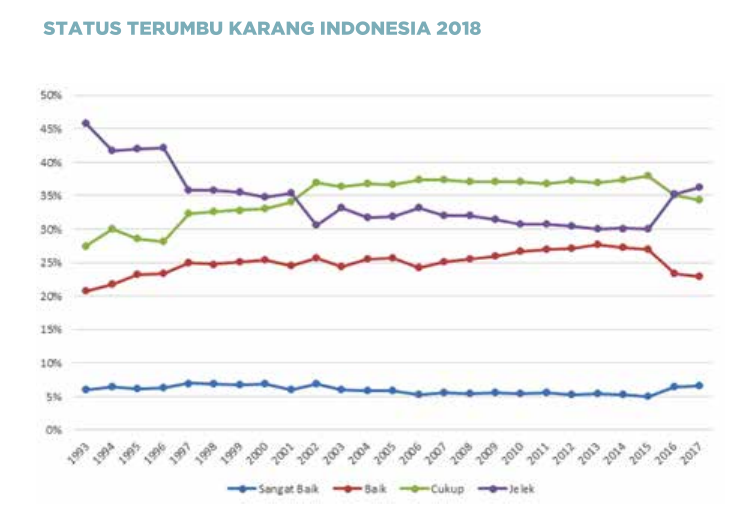
Surprisingly, the coral reefs are in average in a worse shape in eastern Indonesia, despite a lower population density and prime natural conditions.
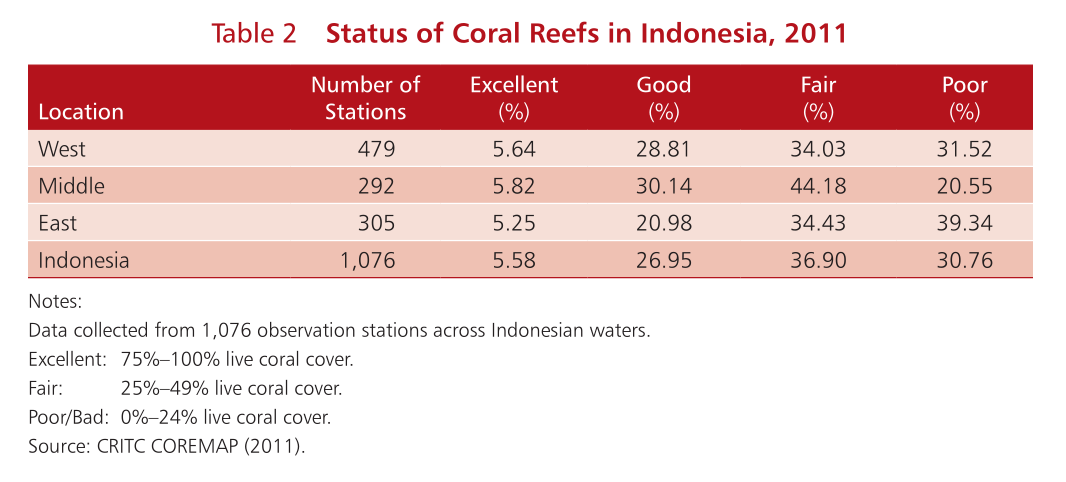
The main reasons behind the degradation of coral reefs are human-related : exploitation of corals to make building foundation, lime and the widespread destructive fishing practices (blast fishing, usage of cyanide or potassium to stunt fishes, bottom trawlers …).
It’s nonetheless important to stress that nature itself can be a major threat to coral reefs : in the aftermath of the 2004 tsunami in Aceh and North Sumatra, the national agency for development planning (BAPPENAS) estimated that around 30% of 97’250 ha of coral reefs had been lost in the disaster.
Bleaching episodes have also been observed locally in 2015 and 2016.
Several coral restoration efforts have been undertaken since 20 years (for instance the Coral Reef Rehabilitation and Management Program > COREMAP launched in 1998…) but their impact seems to be neglectable.
Nevertheless very encouraging reports from marine reserve suggest that nature has a powerful ability to recover once left undisturbed. I hope that increasing regulating efforts on boats and fishery that are currently happening will be able to globally reverse the deteriorating trend.
I have also seen truly marvelous coral reefs while diving in Indonesia and I personally support strict regulation and education campaign to curb the potential negative impact of tourism on such places. Unfortunately I don’t see any better solutions that implementing price barrier (such as in Raja Ampat) for that.
Indonesia is the largest provider of living corals for the ornamental fish industry, amounting to half of the world supplies (Jakarta Post). Most of it is farmed in coral farms.
A 2005 regulation oblige coral farmers to return 10% of the corals produced to their natural ecosystem.
This has generated tension on some rather rare endemic species on high demand. For instance the Banggai cardinal fish has been classified as partly protected species in 2018 in order to preserve the specie in the wild (Mongabay).
Is fishing sustainable in Indonesia ?
Indonesia fishery characteristics
Indonesia is a world fishing powerhouse. It’s the second fish-producing country in the world with more than 6 million tons produced in 2016. Indonesia is behind China (15 tons) but way above United States (around 5 million tons), India (3,6 million tons) or Japan (3,2 million tons) (Source : FAO).
Yet Indonesia, unlike close neighbors like Vietnam or Thailand, is not a major fish exporter. Fishing serves mostly the local population : in 2000 about 60% of animal protein consumed in the country were coming from seafood (ADB 2014). According to Maritime Affairs and Fishery Ministry data only 3,5% of the production was processed through modern methods like canning or freezing in 2011.
The most important catches of Indonesian fishermen are tuna and mackerel species. Indonesia is the largest catcher of tuna in the world (mostly skipjack and yellowfin tunas) capturing more fish than both Japan and Taiwan combined (world no.2 and no.3 producers).
Indonesia is also a major producer or shrimp (4th producer in the world), crabs and spiny lobsters.
Indonesia’s fishery is mostly made of small independent fishermen. According to Maritime Affairs and Fishery Minister data, there are 600’000 registered fishing vessels in Indonesia, of which 89% below 10 gross tones (Mongabay). A fishing boat is considered large from 100 gross tones.
Aquaculture is important for the country and represents 50% of the production. The main products are seaweed, shrimps, milkfish, nile tilapia and carps (see ADB 2014 p.29 for 2009 details).
Indonesia has heavily deforested mangroves to build shrimp-farming ponds but today only 40% of those farms are in production. The Indonesian government plans to restore 300’000 ha of idle farming ponds (Mongabay).
Indonesia is also one the leading supplier of fish for aquarium. This industry employs 12’000 people in the country and the industry is growing by 13% annually since 2015. In 2018 exports of decorative fish generated 4,3 trillion rupiah of revenue (slightly less than 300 millions USD). The government seeks to emancipate from using Singapour as the main export platform (Jakarta Post).
The status of Indonesian fisheries stocks
The Indonesian Maritime Affairs and Fishery Ministry breaks down it statistics by 11 so-called Fishery Management Zones (Wilayah Pengelolaan Perikanan or WPP).
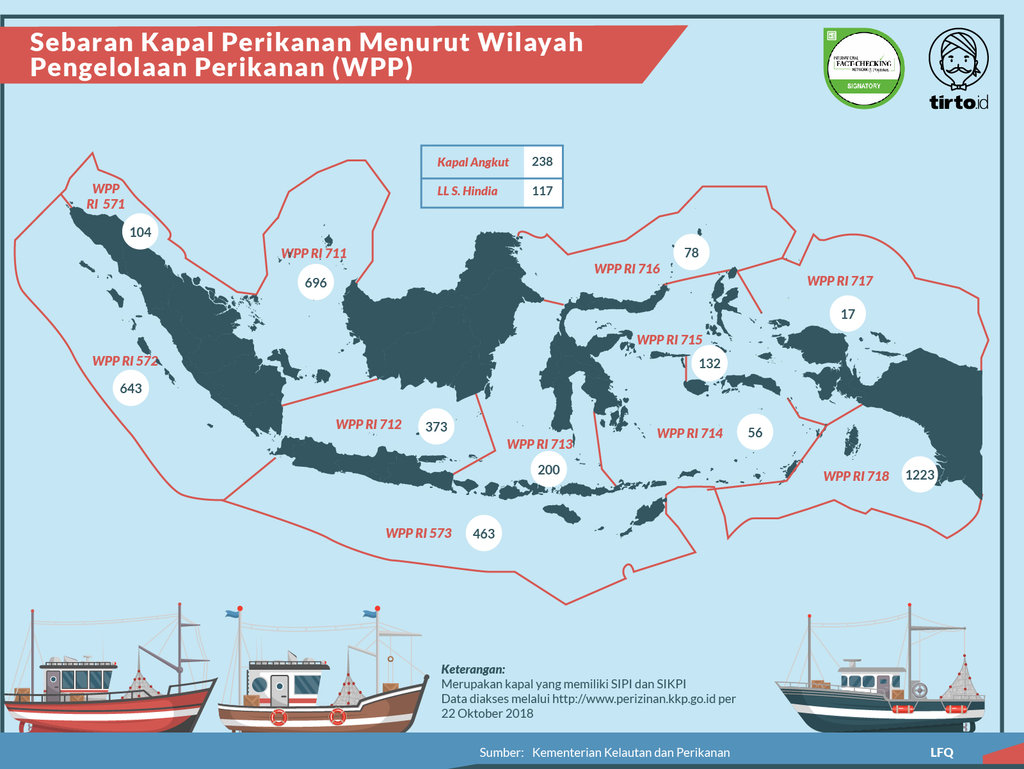
Clear catch statistics are available by species and WPP :
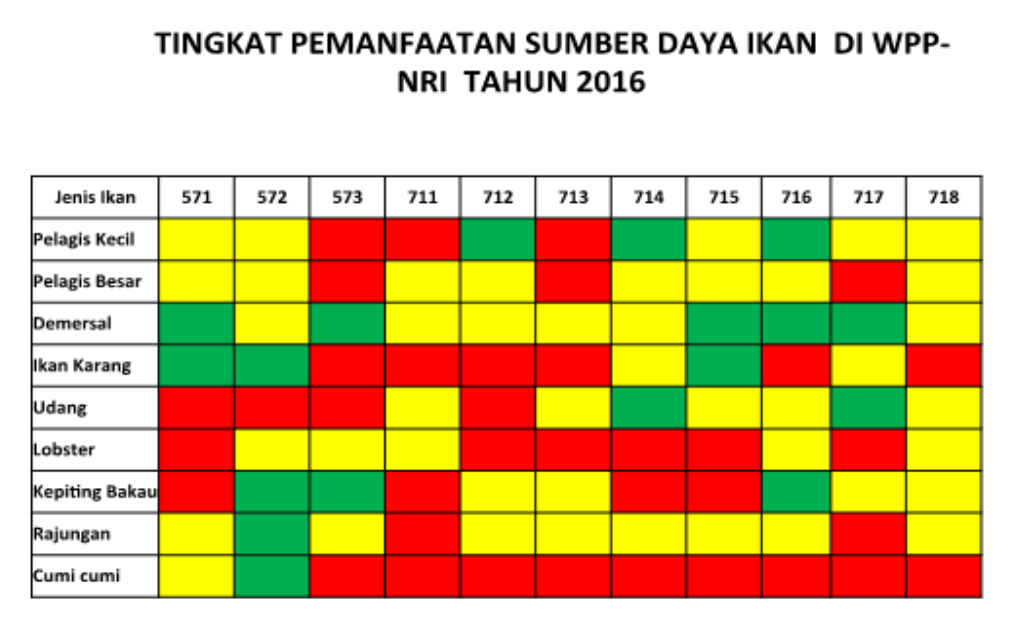
While acknowledging localized overfishing (especially concerning shrimps, squids, reef fishs like groupers and spiny lobsters) the Indonesian authority supports that the country could sustainably reach a yearly marine production of 12 tons (today : 6 tons).
The species with the highest potential are small pelagics (jack, yellowtail scads, sardines…), large pelagics (tuna, mackerel …) and demersal fishs (red snappers, white pomfret …).
Tuna industry is especially monitored by the authorities who certainly envy Thailand $2 billions yearly export of canned tuna (only $300 millions for Indonesia despite behind the largest producer worldwide).
A major issue for such ambitions are the lack of marine infrastructure to link parts of the archipelago. It’s 3 times cheaper to ship fish from China to Jakarta than from Papua to Jakarta (Detik Finance) !
Fishery policies in Indonesia
Under the leadership of Minister Susi Pudjiastuti, Indonesia has embarked itself on an ambitious fishery global reform since late 2014, revolving around 3 axis :
- Management of fish catch through monitoring and control
- Enhancement of aquaculture production
- Increase the added value of fisheries processed production
Fisheries are seen as an economic asset to be developed but also as a human development tool.
The Jokowi government has vowed to develop fish consumption in Indonesia as a source of protein. It is also seen as a part of the solution to reduce stunting among newborns.
According to government statistics fish consumption per capita increased from 38 kg in 2014 to 56kg in 2019. And the goal is now to reach more than 60kg by 2024 (Antara News).
Fight against illegal fishing boats
At the forefront of the recent action of the Ministry was the crackdown on foreign vessels fishing illegally within Indonesia’s Exclusive Economic Zone (EEZ). From 2014 to 2019, Pudjiastuti claimed to have sunk 556 vessels (including 26 Indonesian flagged boats) (Antara News).
I couldn’t found clear evidence for that but the figure of 10’000 foreign fishing boats deterred from entering Indonesia’s EEZ is circulating.
According to an analysis published in April 2018 (Cabral & al), the policy resulted in a 40% decrease of the fishing efforts in Indonesian waters.
The idea of the government is to fill the space left empty by foreign vessels with a more modern domestic fleet of fishing vessels of 30 gross tones or less.
Even when factoring in this incoming waves of newer ships, the authors estimated that the policy implemented is likely to decrease the fishing effort by 25 to 30% compared to the initial situation.
Fight against destructive fishing practices
Another very unpopular measure was taken in 2015 by strictly forbidding trawl nets (cantrang). Trawl nets are deemed unsustainable because of the potential damages they cause to sea bottoms as well as the high quantity of bycatches.
Indonesia has a complicated story with trawl nets. They were introduced in the 70s mostly by large foreign vessels who had secured fishing permits from the government. But they quickly generated tensions with local small scale fishermen who lamented a decline in their own catch.
Trawlers were banned in 1980 before being re-allowed in 1997 for small vessels (under 5 gross tonnes) (Detik).
Another very urgent issue is the fight against blast fishing.
Blast fishing
Blast fishing is illegal by Indonesian law (UU No 31/2004) and can be sanctioned by up to five years in prison as well as a 2 billion rupiah fine. Yet, it’s rather easy for rogue fishermen to escape police on the world longest coastline.
Many methods are possible : from filling up a bottle with fertilizer and attach a fuse to it, to pouring cyanide directly in the water or even using gunpowder from discarded WWII shells left in Morotai islands !
Blast fishing offers short-term gains but they often come at a price :
- Permanently incapacitating accidents due to explosion are common.
- Blast fishing has devastative effects on fish habitats and depletes for years the availability of fish in concerned area.
Local government officials and NGOs have been patiently educating local communities and in several places fishermen are turning themselves into anti-blast fishing militants. For instance this report of a blast fishermen caught after a police report from local villagers (Mongabay).
Blast fishing is still occurring ; even though some offenders are brought to court every year and sentenced to jail (for instance in North Maluku).
Yet, sentences of 1 year in jail commonly given are considered too light for some actors (Mongabay).
Fishery regulation
Fisheries are regulated in Indonesia.
Boats must be registered, fishing permits obtained and catch quotas called Jumlah Tangkapan Diperbolehkan (JTD) are defined by ministry decision (Keputusan Menteri Kelautan dan Perikanan Nomor 47/KEPMEN-KP/2016).
Yet, as we will see for the case of shark fishing, enforcing regulation is the hardest part of the job and many loopholes are still existing.
On top of that, one must keep in mind that a very large share of Indonesian fishermen are small-scale, independent operations with limited means. Most of them are quite poor.
Indonesia currently waives permit requirement for boats smaller than 10 gross tonnes.
For those above the threshold, obtaining proper documentation is often resented as complicated by operators (Mongabay) and many end up operating without proper authorizations.
A so-called Omnibus Law bill is currently (May 2020) debated in Indonesian parliament. It currently includes dispositions merging all currently existing fishing licenses and registration into one single license managed by the central government (many more arguments in this Mongabay article).
It also worthing nothing that some private fisheries have obtained or are in the process to obtain sustainability certifications such as the one delivered by the Marine Stewardship Council (a non profit organization based on London).
MSC requires proofs that fish comes from healthy fish stocks and are captured using environmental friendly methods (handlines, polelines and troll for tuna for instance).
Ocean conservation in Indonesia
Protected species
Indonesian coastal communities traditionally eat anything they catch : shark, dolphins, rays even stranded whales. They don’t specifically seek them, but don’t waste it if they happen to haul them.
This is how things went by for centuries.
The introduction of modern techniques into fishing, alongside global population increase, now raise the issue of the sustainability of ancient practices.
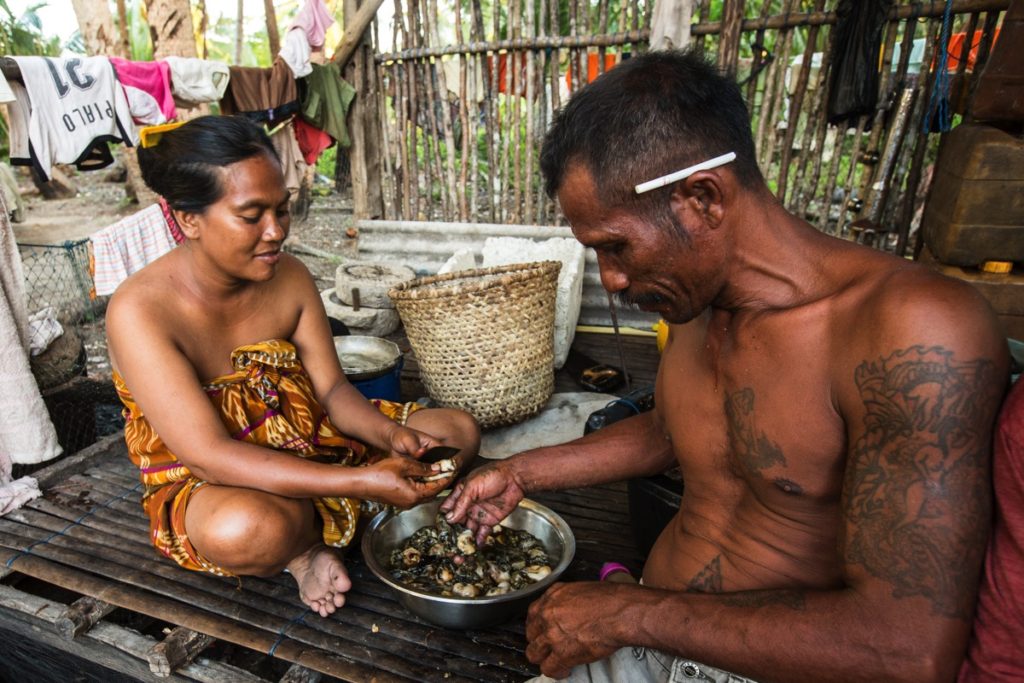
Preparing freshly harvested sea shells
Few species are fully protected under Indonesian laws (prohibited to catch, trade and export them) :
- Whalesharks and sawfish
- All species of cetacea (whales and dolphins) as well as dugongs
- All species of manta rays (since 2014)
- All species of sea turtles (leatherback, loggerhead, hawksbill, olive ridley, flatback and green turtle)
- Most species of giant clams
Yet local populations still regularly catch and sell protected species such as dolphins, giant clams (Mongabay), , humphead wrasse, turtle eggs (Mongabay) or turtles itself (Jakarta Post).
Some are sought after as delicacies (such as turtle eggs or clams), other are even enshrined in cultural practices : consumption of turtle meat is traditional at Mentawai (Mongabay) or Bajo festivals.
There is also the economical factor. For instance, in December 2019 a villager in North Sumatra slaughtered a 213kg leatherback turtle to sold its meat to local residents (Jakarta Post). Let’s say 30% of the weight was sold as meat so 70kg, at 25’000Rp a kilo it’s a 1’750’000Rp revenue. The minimum monthly wage in North Sumatra is 2’500’000 as of 2020 …
Authorities usually adopt a soft policy towards local : explaining environmental laws in schools and providing benefits for fishermen releasing involuntary protected catches in the sea (such as new fishing nets). See for instance this article from Mongabay about Morotai villagers who intended to tame a dugong (Mongabay).
Indonesia may lack the ressource to fully enforce its conservation regulation, it nonetheless becomes more comprehensive with time. The full protection of manta rays was obtained only in 2014.
I understand that the Indonesia government doesn’t want to criminalize millions of people for just living traditionnaly in coastal communities. The question is : will mentality change fast enough to preserve some species from extinction ?
That’s a hard one to answer rationally because surveying population of marine animals is obviously difficult.
Marine reserves
In 2017, 19 million hectares of Indonesian seas were protected as conservation marine reserves. Some of them have been granted the status of national park such as Taka Bonerate, Komodo or Togian archipelago.
The government intends to keep on developing new reserves such as in North Maluku in 2019 (Mongabay).
2016 law on marine protected areas (MPAs) forbids boat over 10 gross tones to enter such areas and only allows traditional small scale fishermen to operate in them.
Marine tourism (especially diving) is often thriving in such places. Patrols are also reinforced to fight off illegal fishing vessels and destructive fishing practices.
Recent very encouraging results are coming up from marine reserve :
- Bejarano & al surveyed fish stocks over 2 periods (2006-2009 and 2012-2013) in Karimunjawa islands (Central Java). In 2011, large drive nets were banned in the park. The authors observed that fish stocks had doubled in the surveyed area after the ban.
- Misool Private Marine Reserve (an emanation of luxury dive resort Misool Eco Resort) communicated even more spectacular results : a 3,5x increase in biomass between 2007 (prior to the establishment of the reserve) and 2013.
Oceans between conservation and economic developments : the case of shark fining
According to the Indonesian government 120 species of shark out of the 500 known are found in Indonesian waters as well as 101 out of 650 known ray species. Wildlife Conservation Society refers to 114 species of shark and 101 species of rays.
For those interested in taxonomy, I found this presentation of around 60 species of Indonesian sharks (with pictures) by the government.
A profitable industry
From the late 70s, Indonesian fishermen started to answer growing international demand for shark fins, commonly attributed to the emergence of the Chinese middle class that adopted the culinary traditions of the elite.
Sharks are often caught as by-catch (for instance by long line fishing boats targeting tunas) but they are also specifically targeted by fishermen operating notoriously from Cilacap (Central Java) and Tanjung Luar (Lombok).
According to the head of fishery of the Nusa Tenggara Barat province, the shark and ray markets in Tanjung Luar generates around 8 billion rupiah yearly (about 500’000 USD) (Mongabay).
A fishermen can earn as much as 7 million rupiah per shark fished : fins alone are worth around 1,5-3 million each and the meat is sold 25’000Rp per kg (SCMP).
Based on local countings, it is estimated that between 6000 and 8000 sharks (primarily silky sharks, tiger sharks and blacktip sharks are hauled every year in Tanjung Luar only.
According to the FAO statistics, Indonesia is the largest exporter of shark fins in the world.
Overfishing and regulation
In its 2016-2020 conservation plan for sharks and rays, the Indonesian authorities acknowledge that “almost all shark and ray species with an economic value are already facing extinction risk” (p.7).
Yet few species are fully protected under Indonesia law. Actually there are only 2 : the whale shark and the sawfish.
Others are listed under the Convention on International Trade in Endangered Species of Wild Fauna and Flora (CITES). It means that they are internationally considered endangered and can be exported only under strict regulation.
Silky sharks, hammerhead sharks, shortfin mako sharks and thresher sharks are all listed under CITES and according to Indonesian law hammerhead sharks products are ban from exports and silky shark products are submitted to quota.
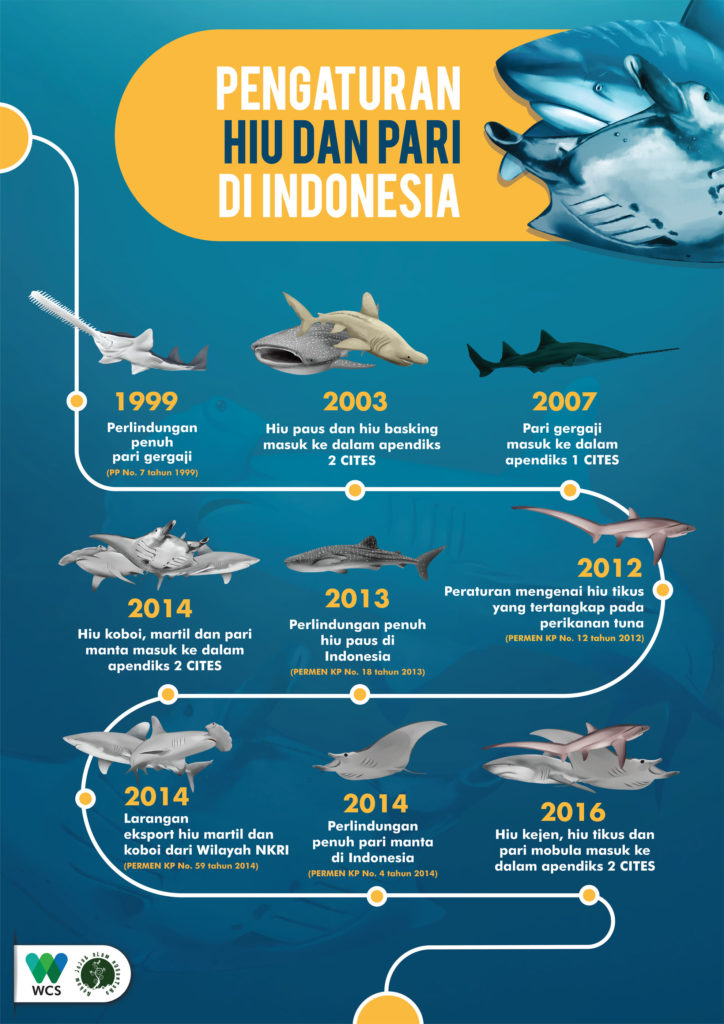
As we can see, much of the recent regulation is rather recent and probably derives from growing concerns about rapid depletion of shark stocks by the KKP.
Nonetheless, it’s very likely that stricter conservation measure will be soon required. Investigation of Tempo in January 2020 exposed that the shark fining industry was marred with fraud : fins from protected species are routinely hidden alongside legal ones.
Shark fishing can be sustainable as long as it leaves undisturbed endangered species. Other shark species are still abundant today.
Sources
- Direktorat Konservasi dan Keanekaragaman Hayati Laut, 2015, Rencana Aksi Nasional Konservasi dan Pengelolaan Hiu dan Pari 2016-2020 (source)
- Direktorat Konservasi dan Keanekaragaman Hayati Laut, 2016, Rencana Aksi Nasional Konservasi Dugong dan Habitatnya (Lamun) di Indonesia 2017-2021 (source)
- Asian Development Bank, 2014, State of the Coral Triangle: Indonesia (source).
- Kementerian Kelautan dan Perikanan, 2015, Rencana Aksi Nasional Konservasi Cetacea Indonesia 2016-2020 (source). See page 9 for a full lists of cetacea found in Indonesia.
- Victor B., May 2015, How many coral reef fish species are there? Cryptic diversity and the new molecular taxonomy in Ecology of Fishes on Coral Reefs, edited by Camilo Mora, Cambridge University Press, 2015.
- Cabral & al, April 2018, Rapid and lasting gains from solving illegal fishing, Nature Ecology & Evolution Vol.2, April 2018, 650-658.
- Pusat Penelitian Oseanografi, 2018, Status Terumbu Karang 2018, Lembaga Ilmu Pengetahuan Indonesia (LIPI) (source)
- FAO, 2018, The State of World Fisheries and Aquaculture 2018 – Meeting the sustainable development goals (source)
- Suman A. & al, Status stok sumber daya ikan tahun 2016 di wilayah pengelolaan perikanan Negara Republik Indonesia (WPP NRI) dan alternatif pengelolaannya, Jurnal Kebijakan Perikanan Indonesia, Volume 10 Nomor 2 November 2018 (source).
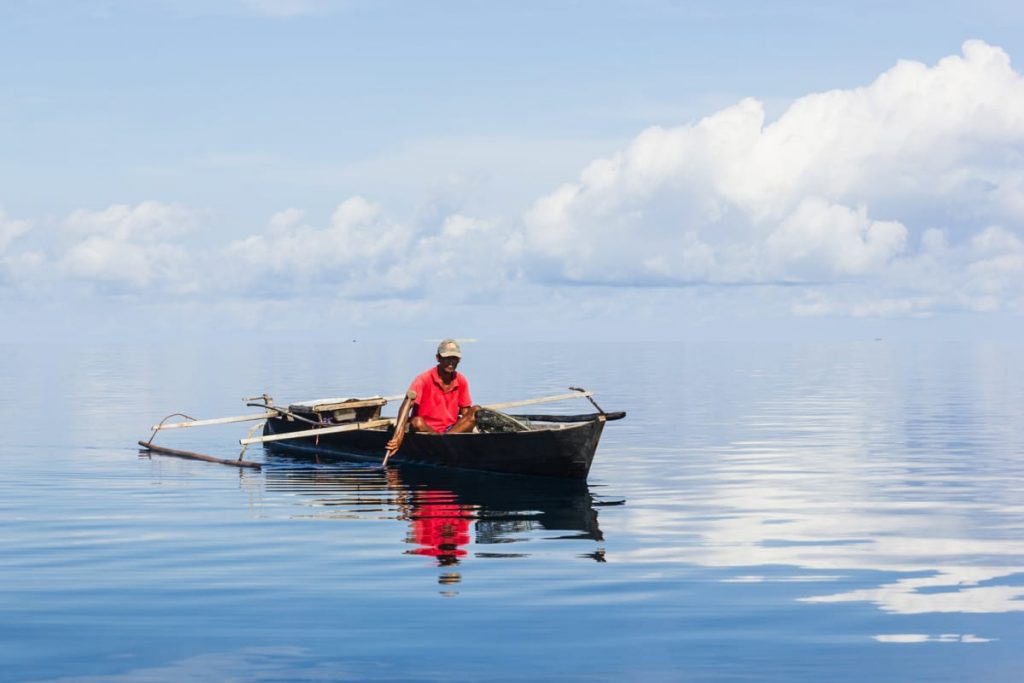
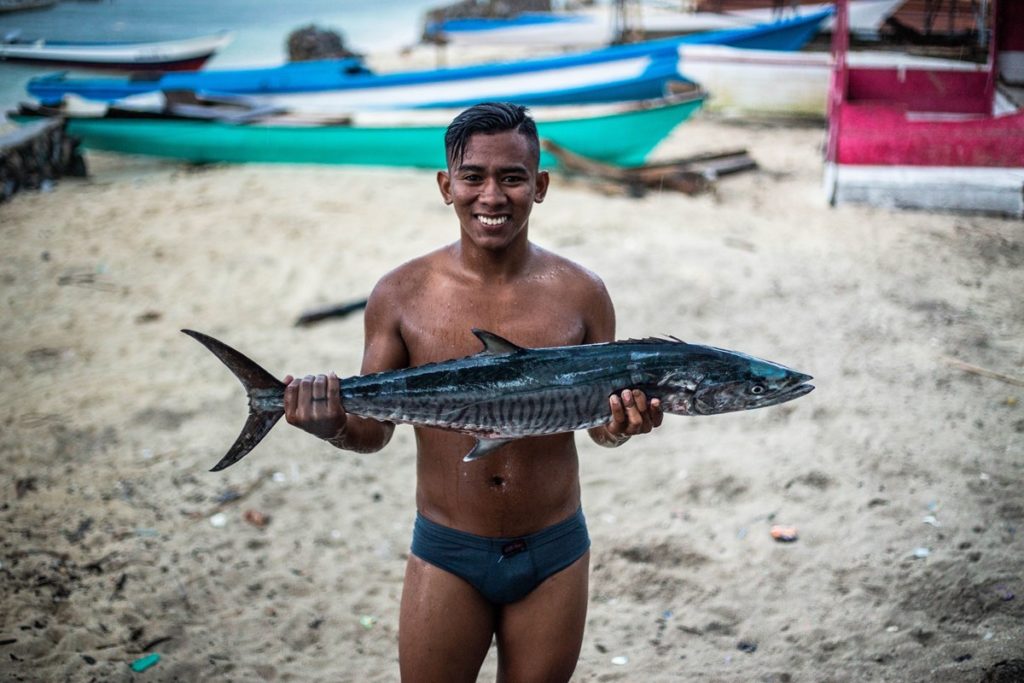
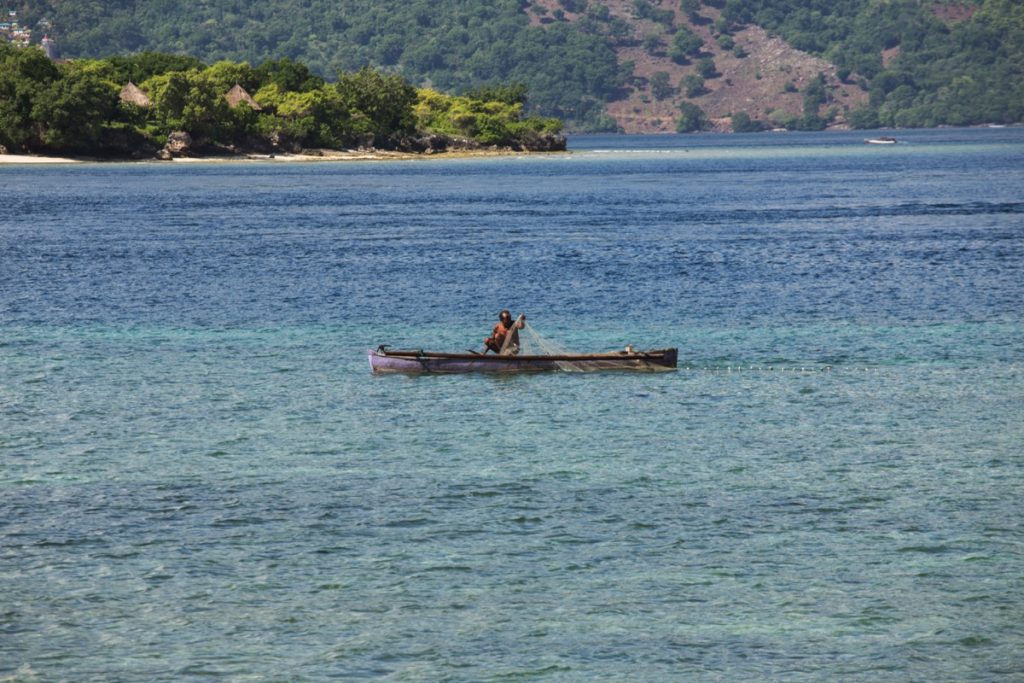
Leave a Reply